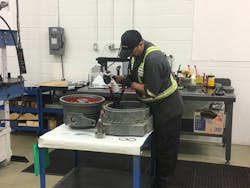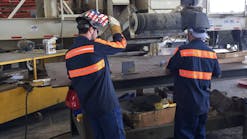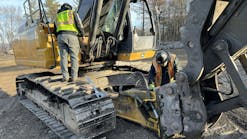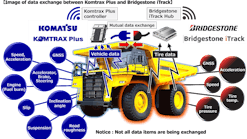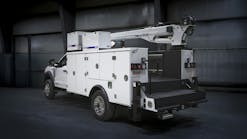In addition to a labor and microchip shortage, Covid-19 and its economic fallout has disrupted the supply chain, which have affected parts and components availability and helped delay the manufacture and delivery of new equipment. Used and rental inventories have suffered as well due to increased demand from fleets attempting to fill gaps.
Finally, at long last, infrastructure funding will be coming down from on high, meaning more jobs and the need for additional iron to complete them. It may not be the proverbial perfect storm, but there is seemingly one storm here and another dark cloud on the horizon.
The net result of all of these dominoes falling is the need to make tough decisions: What can be done to keep current assets running longer?
What is a machine rebuild?
One option is rebuilding/refurbishing older equipment. The classic definition is reassembling and replacing components to restore the machine to its state when originally manufactured. Included in a machine rebuild are mechanical components that can be removed and inspected, as well as the “deeper” items such as electrical systems and other components that can usually only be evaluated by diagnostics. Also, refurbishment often ranges outward to encompass the more cosmetic features that are easily visible, such as paint and cab amenities.
Whether the work is done by an OEM, in-house, or by a dealer, today’s business conditions complicate the machine rebuild decision.
Aaron Mayer, equipment manager for earthmover Ryan Incorporated Central, Janesville, Wisconsin, primarily rebuilds what he terms the company’s lower utilization equipment, such as compactors, haul road motor graders, and D8-sized pull tractors that can pull dolly wheel scrapers.
“On the compaction equipment, instead of looking to acquire some of the newer stuff, we’ve been acquiring some older machines to rebuild, because we are concerned with the emissions considerations,” Mayer says. “Frankly, with a lot of the new equipment the last two years, electronic components, especially sensors, have been an Achilles heel because with the emissions systems, if there’s a fault code or something, the machines have to de-rate.”
Mayer says many of the fault codes are being caused by sensor issues, and he has had a rash of instances where he could not acquire replacement sensors. “So, you have a whole machine down because of a $300 or $500 part,” he says.
Procuring parts for rebuilds has been a major issue affecting the timing of the rebuild decision.
“In the past, we would be talking to the dealers about rebuilds in the fall because we’d know when the machine’s going to be finished [working]—we want to make sure we get all the hours out of the life—and then we would go through the process of getting quotes and selecting a vendor to rebuild it,” Mayer says. “So, we might start that process in November, move a machine to a dealer in December, they would order the parts, and the machine would be ready for service March 1st.
“Today, we actually have to start that process in July,” Mayer says. “This winter, we’re doing 11 rebuilds, and on nine of them, we made the commitments in July and August. So the machines didn’t get delivered to the dealers until early in December, but we had to order the parts that early just to get them. We have two machines at a dealer right now, and they’re held up for parts that have been ordered since the fall.”
Just as parts are delayed, new machine delays have changed acquisition planning and might also force extra rebuild decisions. Mayer admits that because Ryan Central has major account status with more than one OEM, he has a bit of an advantage.
“As a national account, we have additional visibility and ability to get those production slots and get elevated attention that the average customer doesn’t have,” Mayer says. “I think for those smaller customers, it’s tough. What does the smaller person do? I know one manufacturer right now that is currently not scheduling new orders and basically trying to get through all the orders they have that were placed in late 2020 and early 2021, and they’re prioritizing larger accounts.
“So for the small guy, you might have a job and you might have a piece of equipment that you ordered, or one that you plan to order, and it just isn’t available, so it forces you to go look somewhere else,” Mayer says. “You might have a customer that’s had a John Deere or Cat dozer for years and they’re at the point where they have to either rebuild or make a significant investment into what they have, which is a challenge because of parts availability. If I were to decide today that I can’t get a new machine, I have this older machine and I want to do a rebuild on it, expecting someone to rebuild it in three or four months is just unrealistic right now. They can’t get the parts.”
Mayer says that despite the headwinds in the industry, the changes he’s had to make are not big ones.
“For us, we have economies of scale and a lot of data to support the strategy we have, and as difficult as it is, what we’ve had to do is change our commitment timing. But the rest of our strategy hasn’t changed all that much,” he says. “We have to stock more parts than we usually do, stock major components, and we’re ordering machines and committing to rebuilds earlier, but our overall long-term strategy hasn’t changed that much.”
Which machines to rebuild?
Thad Pirtle, CEM, VP of equipment for Traylor Brothers, a heavy civil contractor that works throughout North America, takes a spot approach to its rebuilds. It typically rebuilds larger, one-off specialty machines like electric locomotives, specialty lifting equipment, and customized tunnelling equipment, usually because these machines are not available “off the shelf.” Traylor will look to rebuild earthmovers if the situation is right.
“We’re doing stuff to equipment to make it last; if it’s got a seven-year life, we’ll do a light refurbish on it or send it to a dealer and have it spruced up to try and make a couple of more years with it to get through this valley we’re in,” Pirtle says.
“We rely heavily on equipment dealers, but we may also take a piece of equipment in and pull the hydraulic pumps off of it and have them tested along with oil sampling,” Pirtle says. “If it tests above 85 percent, then we’ll put them back on and use them. If they’re less than that, they’ll get a rebuild.
“On cranes, we’ll do it on our own, either at our facility or at Smith Power out of Reno; we have done several on Liebherr Cranes, as well as a multitude of yellow iron. We’ll investigate the hydraulics, remove the gearboxes, remove the pump drives and rebuild those,” Pirtle says. “We know from experience that has to be done every so many hours, and then we also remove the pumps and motors and have them tested, replace the hydraulic hoses, and update the electrical systems, including safety devices and operator aids.”
Cost is the major factor in most decisions. “It depends on what we think the cost of the rebuild is going to be,” Pirtle says. “If it’s going to come out above the 50 percent of new, it pretty much gets axed. It’s got to be somewhere between 50 and 75 percent; a complete new refurbish needs to be less than 75 percent of new and give you at least 98 to 99 percent reliability. A lot of that depends on how many moving parts it has—the rebuildability of a machine is relative to how many moving parts it has—the fewer moving parts, the more rebuildable it is. A crane or a fork truck, something like that is relatively simple to rebuild, but a manlift or hydraulic crane, they’re a little bit different.”
The realities of limited equipment availability and approaching infrastructure funding has Pirtle considering more rebuilds “because you can’t replace them with anything that’s in the field right now; there’s nothing new to replace them with.”
New tech features further complicate the decision for some managers. “I think what’s going to drive a lot of the rebuilds, too, is technology,” Pirtle says. “As new equipment gets more sophisticated, there’s a large group of people out there who don’t like it, and they want simplicity. So, they’ll go back and pick up older equipment and rebuild it because it doesn’t have the sophisticated electronics and computers on it. I’ve seen a lot of that in the last few years, which is a little surprising.”
Pirtle says he likely doesn’t have enough equipment at this time for jobs that infrastructure funding may open up to the bids his company typically wins, and he’s probably not alone. “Infrastructure is going to impact us for sure and there’s going to be more work out there than we’ll even be able to bid. So, there’s probably going to be an influx of foreign contractors,” he says.
The foundation of the rebuild decision is knowing a machine’s value, according to Pirtle.
“Manage your market values of your equipment. Keep track of it so you can see when things are changing,” he says. “When you bought a backhoe for $80,000, and you run it for seven years, and its first life is done, you’ll look at the replacement on that and it’s, say, $200,000. If you only need a backhoe to run 400 to 500 hours a year on a small job, then you probably don’t need a $200,000 backhoe. You can probably take that $80,000 unit and refurbish it for $20,000 to $25,000 and do the job.
“There are efficiencies to be gained by that and I think people need to understand what a piece of equipment is worth, what you can turn it into cash for at Ritchie Bros, and what it would take to refurbish it and maybe do another job with it,” Pirtle says. “It may not be a full seven-year stint, but it might be another two- or three-year stint.
“I think people need to manage their equipment a little bit closer as far as market values go and replacement values, and keep their arms around that,” he says. “Keep them current. Once a year, everything needs to have a new market value put on it, good or bad. Ask yourself what can you turn it into cash for, and that will help drive your decision-making process as to whether you want to spend a few bucks on it for refurbishing.”
